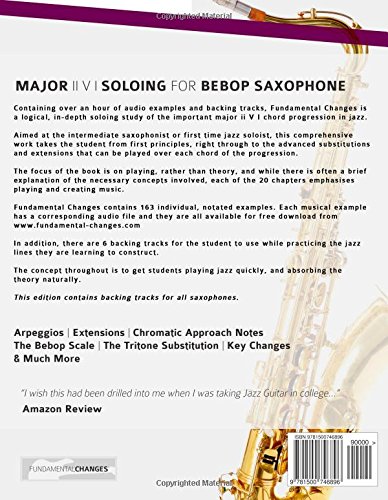



Full description not available
B**E
I look forward to what I'll sound like next year this time
I'll begin with what this book is not. It is not another “Thesaurus of Scales and Melodic Patterns” – by Nicolas Slonimsky nor “Patterns For Improvisation” – by Oliver Nelson. This book is Not for beginners. I've had a couple years of college level music theory including some Jazz theory and I learned some new approaches from the discussion of the exercises. Perhaps I had heard it before but the way it was presented in this work seemed to click.With the basic examples and accompanying audio that follows the text discussed in each chapter, one is left with the job of writing down your own ideas and/or lifting ideas off recordings. Much emphasis is put on practicing the method. “Be patient, go slowly and only progress to the next chapter when you're playing my licks and your own ideas confidently over the mid tempo ii V I backing track.” And “You should move on only when you can see and hear each note you play as an extension of the chord you're playing over. Remember your home key!” In addition, “Get into the discipline of writing down your ideas, and learning them with a slow backing track….” So it also incorporates ear training as you practice each exercise.Throughout the book the emphasis is put on playing. Beginning with simple arpeggios it progresses to chromatics, extensions, the bebop scale and guiding tones. Almost the last quarter of the book focuses on the tritone substitution and its extensions. The following quote surprised me, “[Pat Metheny]… mentions that if you analyse virtually all of John Coltrane’s later soloing, it can often be seen in terms of him playing dominant chords with tritone substitutions, with all the extensions available all the time.” I wish this had been drilled into me when I was taking Jazz Guitar in college. It concludes with a discussion and exercises on playing the ideas in different keys (all examples except the final chapter are in the key of C).Now I have about 6-9 months of woodshedding to implement all the ideas incorporated in the short course. I look forward to what I'll sound like next year this time. If you have a bit of theory under your belt and aren't afraid to do a lot of your own work (practice) then this book could be for you.
M**E
Excellent!
Another excellent book on Jazz improvisation. It would help if you know jazz music theory. I gave it a five star because it gives you a logical and structured way to learn and be comfortable with improvisation. Really good book! This book has answered questions for me about the melodic improvisations from book transcriptions of major jazz artists like Coltrane and Parker. If you study this book, I guarantee you won't regret it.
P**R
Another Jazz book.
Another Jazz book. It's a bit long-winded but does contain some useful ideas on developing improvising skills.
K**N
Good
Good information.
D**N
Five Stars
Very Good
D**D
Perfect structure. Works on Kindle.
I've gone through numerous online materials and courses aimed at breaking down improvisation into steps. They all revolve around the same basic idea of chord tones, voice leading and chromatically connecting tones. This book is the resource that made this concept click.The reason is that the book breaks the process down into small steps with very simple exercises. The others do this too, but this does it better. It emphasises the need to hear notes not just play them. It also departs from chord tones fairly early to encourage the player to explore the stuff that jazz musicians actually play.One example of the insights in the book is that bebop solos are mostly combinations of arpeggios and scale runs. Although perhaps obvious, this makes the reader feel that the goal of soloing is more attainable. There are many more specific examples of breaking problems into smaller problems.The Kindle version of the book works fine because all the exercises are 4 bars long, which is easy to show in Kindle, especially in landscape.
N**E
Good book - link to backing tracks does not work
Not one to whinge - the book is good - but the link provided for the backing tracks does not work. Kind of important really.
T**B
Útil...si trabajas
Ya sabes que en música, y sobre todo en improvisación, no hay trucos ni milagros, hay trabajo, estudio, pero el trabajo y el estudio necesitan de una guía. Este método es una buena referencia, pero no funciona con tan solo mirarla
R**R
Excelente método progresivo
Vaya! Por fin encuentro un método adecuado a mi nivel. Si bien es cierto que son necesarios conocimientos previos de armonía, comienza con conceptos bastante básicos y de manera muy progresiva te lleva de la mano hasta capítulos de sustitución tritonal, acordes extendidos, etc. Creo que no se deja nada por explicar. Aunque el objetivo final sea la improvisación bebopera, se empieza con ejercicios basados en arpregios sobre cambios de acordes. Aquí hay años de estudio, pero como comento todo muy bien hilado y explicado (en inglés). Los ejercicios están escritos en la tonalidad de Do (Dm-G7-C), con lo que la transposición a los once tonos restantes queda del lado del estudiante.Es mi opinión está muy completo y muy bien, no sólo para el Bebop sino como método de estudio enfocado a la improvisación del Jazz en general.
Trustpilot
1 week ago
1 week ago